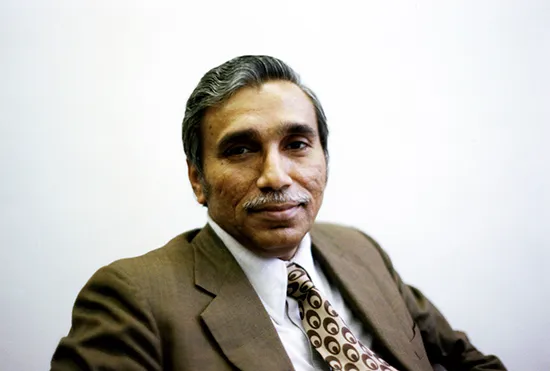Fazlur Rahman Khan - the father of tubular designs
Have you ever wondered how modern skyscrapers - these giants of steel and glass manage to defy gravity and reach such dizzying heights? The answer lies in the pioneering work of Bangladeshi-American structural engineer Fazlur Rahman Khan, also known as the "Father of Tubular Designs."
Born in 1929 in Dhaka, then part of British India, Fazlur Khan's early life was steeped in a love for mathematics. His father, a rural math teacher, instilled in him a passion for numbers and spatial reasoning. This foundation would prove invaluable in his future career.
After completing his schooling in Bangladesh, Khan set his sights on higher education in the United States. He earned a bachelor's degree in civil engineering from the University of Illinois Urbana-Champaign in 1955, followed by a master's degree from the prestigious Massachusetts Institute of Technology (MIT) in 1957.
During his time at MIT, Khan encountered the limitations of traditional skyscraper design. The prevailing approach relied on a rigid central core to provide structural support. This method limited the height and overall design flexibility of these buildings. Khan, however, envisioned a new way to conquer the sky. He proposed a revolutionary concept: the "tube structure."
Khan's tube design treated the entire exterior wall of a skyscraper as a thin-walled tube. This meant using closely spaced columns and beams around the perimeter of the building to create a rigid framework. Consider for the moment - a sturdy cardboard tube – its strength comes from its continuous form, not just the material itself. Khan's design achieved similar strength-to-weight efficiency and this innovative approach offered several advantages such as increased stability.

The tube structure distributed wind loads more efficiently across the entire building envelope, providing superior resistance to lateral forces like wind and earthquakes. The absence of a bulky central core also allowed for more open floor plans, offering architects greater design freedom and allowing for more usable space within the building. In addition, by using the entire perimeter for structural support, the tube design needed less material compared to traditional methods, making it more cost-effective.
Although ground-breaking, Khan's revolutionary concept was not met with immediate acceptance. Many engineers and architects were sceptical of this radical departure from established practices. However, Khan's unwavering belief in his design, coupled with his persuasive arguments and meticulous calculations, eventually won over the industry.
His first major project to use the tube design was the John Hancock Center in Chicago. Completed in 1970, this iconic 100-story building showcased the potential of Khan's concept. The structure's distinctive trapezoidal shape, designed by architects Skidmore, Owings & Merrill (SOM), wouldn't have been possible without the flexibility offered by the tube design. The building withstood a major construction accident in 1968 and became a symbol of engineering resilience.
Khan's most renowned creation, however, was the Willis Tower (formerly Sears Tower), completed in 1973. This behemoth, at the time the tallest building in the world, stood at 1,451 feet (442 metres) and further solidified Khan's reputation as a visionary engineer. The bundled tube design, a variation on the original concept, used nine square tubes arranged in a cluster to provide exceptional stability and allow for the immense height. These innovative Chicago skyscrapers not only reshaped the city's skyline, but also served as testaments to Khan's ground-breaking ideas.
His pioneering work with tube structures laid the foundation for the continued development of tall buildings. Today, most skyscrapers above 40 stories incorporate variations of his innovative design. Khan's legacy is not confined to structural engineering. He was also a champion for computer-aided design (CAD). He recognised the potential of computers to revolutionise the design and construction process and actively encouraged its use in the industry.
Fazlur Rahman Khan's life was tragically cut short in 1982. However, his contributions to the field of structural engineering remain an inspiration to this day. His unwavering belief in innovation, coupled with his meticulous calculations and unwavering passion for his craft, revolutionised the way we build and interact with the urban environment. Khan's legacy extends beyond specific structures; he fostered a spirit of exploration and a willingness to push boundaries within the engineering community.
Khan's holistic approach to design
Khan believed that a successful building was not just about aesthetics or engineering prowess. He advocated for a holistic approach that considered factors like human well-being, energy efficiency and the overall impact on the surrounding environment. He envisioned skyscrapers that functioned not just as isolated structures, but as integrated parts of a vibrant urban ecosystem.
While Chicago became synonymous with his ground-breaking designs, his influence was not limited to the Windy City. He played a key role in the engineering of several iconic structures across the globe, including the Haj Terminal, Jeddah, Saudi Arabia (1976-1981). This innovative airport terminal incorporated a lightweight, tent-like structure inspired by traditional Bedouin tents. The design showcased Khan's ability to adapt his principles to create culturally relevant and functional buildings.
He also brought his skill to design The Hajj Hospital, Mecca, Saudi Arabia (1977-1980): This massive healthcare facility incorporated innovative shading solutions to combat the region's harsh climate. Khan's focus on functionality and human comfort is evident in this project.
However, it has been the future of skyscraper design that has been undoubtedly shaped by Fazlur Khan's innovations. As cities continue to grow vertically, engineers and architects are constantly pushing the boundaries of height, design and sustainability, ongoing trends influenced by Khan's work.
Fazlur Rahman Khan's impact on the field of structural engineering is undeniable. His pioneering work with tube structures revolutionised the way we build skyscrapers, allowing them to reach new heights and incorporate innovative designs. Beyond specific structures, Khan's legacy lies in his unwavering pursuit of innovation, his holistic approach to design, and his commitment to building structures that serve not just as isolated entities but as integral parts of a thriving urban environment. As humanity continues to push the boundaries of construction, Khan's vision will continue to inspire generations of engineers and architects to create ever more impressive and sustainable structures that touch the sky.
Additional Articles

What construction can learn from Ant colonies about logistics and site movement
If you want to witness flawless logistics, responsive movement and coordinated planning in action, you do not need to observe a hyper-automated warehouse or a cutting-edge construction site - you...
Read moreWhy everyone has a favourite skip and what it says about you
In construction, there are two universal truths – tea, of course, is essential and believe it or not, everyone - whether they are prepared to admit it - has a favourite skip. It may sound strange,...
Read more

The cultural significance of the bacon roll in UK construction
Walk onto any construction site in the UK at 7:30am and you’ll quickly discover that the most important piece of equipment isn’t a digger, a drill or a laser level. It’s a humble, foil-wrapped,...
Read more